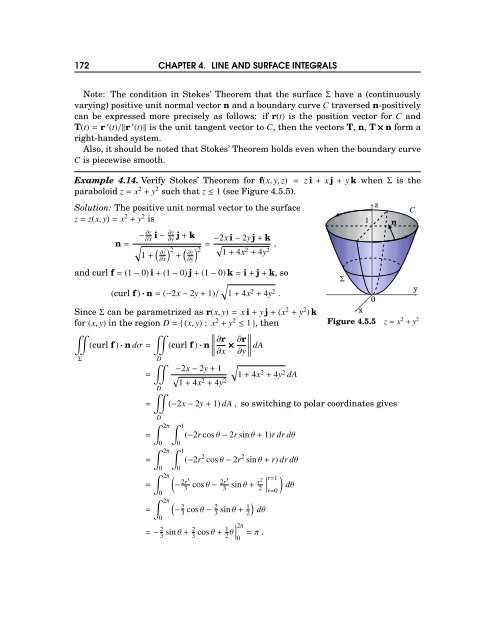Michael Corral: Vector Calculus
Michael Corral: Vector Calculus
Michael Corral: Vector Calculus
Create successful ePaper yourself
Turn your PDF publications into a flip-book with our unique Google optimized e-Paper software.
172 CHAPTER 4. LINE AND SURFACE INTEGRALS<br />
Note: The condition in Stokes’ Theorem that the surfaceΣhave a (continuously<br />
varying) positive unit normal vector n and a boundary curveC traversed n-positively<br />
can be expressed more precisely as follows: if r(t) is the position vector for C and<br />
T(t)=r ′ (t)/‖r ′ (t)‖ is the unit tangent vector to C, then the vectors T, n, T×n form a<br />
right-handed system.<br />
Also, it should be noted that Stokes’ Theorem holds even when the boundary curve<br />
C is piecewise smooth.<br />
Example 4.14. Verify Stokes’ Theorem for f(x,y,z) = zi+ xj+yk whenΣis the<br />
paraboloid z= x 2 +y 2 such that z≤1(see Figure 4.5.5).<br />
Solution: The positive unit normal vector to the surface<br />
z=z(x,y)= x 2 +y 2 is<br />
n= −∂z ∂x i−∂z<br />
√<br />
1+ ( ∂z<br />
∂x<br />
∂y j+k<br />
) 2+ ( ) = −2xi−2yj+k √<br />
∂z<br />
2<br />
1+4x 2 +4y ,<br />
2<br />
∂y<br />
and curl f=(1−0)i+(1−0)j+(1−0)k=i+j+k, so<br />
√<br />
(curl f)·n=(−2x−2y+1)/ 1+4x 2 +4y 2 .<br />
SinceΣcan be parametrized as r(x,y)= xi+yj+(x 2 + y 2 )k<br />
for (x,y) in the region D={(x,y) : x 2 +y 2 ≤ 1}, then<br />
<br />
(curl f)·ndσ= (curl f)·n<br />
∂r<br />
∥∂x ×∂r<br />
∂y∥ dA<br />
Σ<br />
D<br />
<br />
−2x−2y+1<br />
= √<br />
√1+4x 2 +4y 2 dA<br />
1+4x 2 +4y 2<br />
D<br />
D<br />
∫ 2π ∫ 1<br />
1<br />
Σ<br />
y<br />
0<br />
x<br />
Figure 4.5.5 z= x 2 +y 2<br />
<br />
= (−2x−2y+1)dA, so switching to polar coordinates gives<br />
=<br />
=<br />
=<br />
=<br />
0 0<br />
∫ 2π ∫ 1<br />
0<br />
∫ 2π<br />
0<br />
∫ 2π<br />
0<br />
0<br />
(−2rcosθ−2rsinθ+1)rdrdθ<br />
(−2r 2 cosθ−2r 2 sinθ+r)drdθ<br />
(<br />
− 2r3 2r3<br />
3<br />
cosθ−<br />
3 sinθ+ r2 2<br />
(<br />
−<br />
2<br />
3 cosθ− 2 3 sinθ+ 1 2)<br />
dθ<br />
=− 2 3 sinθ+ 2 3 cosθ+ 1 2 θ ∣ ∣∣∣ 2π<br />
0 =π.<br />
∣<br />
∣ r=1<br />
r=0<br />
)<br />
dθ<br />
z<br />
n<br />
C








